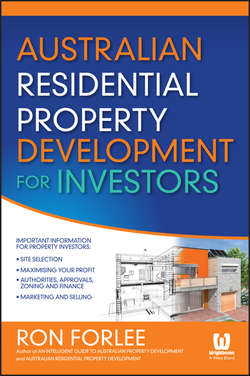Читать книгу Australian Residential Property Development for Investors - Forlee Ron - Страница 11
На сайте Литреса книга снята с продажи.
CHAPTER 1
An overview of property development
Types of residential developments
ОглавлениеResidential developments can be categorised into the following areas.
Renovations
Some older suburbs in capital cities offer exceptional opportunities for renovating older homes and the developer can be rewarded with good returns within a short period. These renovations may require structural alterations or additional rooms or involve no more than adding some paint to bring the building to present market standards.
Speculative homes
The speculative new home is usually built on a single lot in a new land subdivision or on an older block that has been subdivided to create smaller lots, as normally found in older suburbs. Developers can also market ‘house and land' packages, subdividing the land into smaller lots and then selling two contracts, one for the land and the other with a selected building contractor.
Small units
These smaller unit developments of two to six single- or double-storey units are commonly found in suburban areas of both new and old subdivisions and may be defined as villas or townhouses. They can be developed as strata-type units or small green title lots. This scale of development is ideal for the novice developer as they sit in the lower risk category, subject to the developer selecting the right location and undertaking a comprehensive market research and analysis.
Group housing
Under this category one would find a group of eight or more units, which can include townhouses, villas or retirement villages. Each development will have its own architectural theme defined by similar use of materials, scale and building style. Larger projects of 20 or more units are best built in phases in order to mitigate risk and improve cash flow.
Apartments
These buildings are found mainly in the inner-city areas of capital cities. They are defined as dwellings in a group of more than one where any part of a dwelling is built vertically above part of any other. As urban populations grow and infrastructure costs in sprawling cities increase, suburbs close to the central business districts (CBD) with good services and transport systems are allowing increasing densities, which encourages apartment developments.
Government housing
Also known as public or social housing, these developments are provided by the government for members of the community who cannot afford either to purchase their own home or to cover the higher rents demanded in the marketplace. Given their own limited resources, governments cannot provide all the social housing required and will enter into joint ventures with developers or provide tax incentives to developers in providing such housing.
Residential land
These developments can vary in scale from small backyard subdivisions to larger scale suburban community land developments. The latter require intensive town planning in conjunction with the local council's planning department and various other government authorities. While these developments carry less construction risk, the developer will require enough cash to endure the lengthy and protracted approval process.
Niche residential developments
In addition to the foregoing residential developments, we can consider a number of developments as niche markets. These include:
• holiday homes
• timeshare apartments
• cooperative housing
• student accommodation
• lifestyle villages
• caravan parks.
